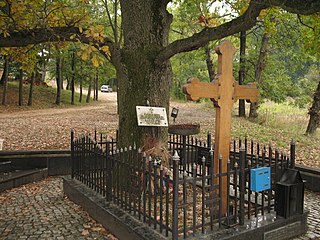This list includes Immovable Cultural Heritage sites in the Rasina District of Serbia. [1]
| Number in the Central Register | Photo | Name | Municipality | Address | Designated since | Classification |
|---|---|---|---|---|---|---|
| AN 27 | Vitkovo Archaeological Site | Aleksandrovac | Vitkovo 43°27′19″N21°06′18″E / 43.455339°N 21.105062°E | 28 February 1969 | ||
| AN 89 | Prehistoric Settlement Archaeological Site | Trstenik | Stragari 43°38′45″N21°08′16″E / 43.645902°N 21.137679°E | 27 December 1989 | ||
| AN 90 | Šupljaja Archaeological Site | Poljna 43°43′23″N21°05′48″E / 43.722937°N 21.096743°E | 27 December 1989 |
| Number in the Central Register | Photo | Name | Municipality | Address | Designated since | Classification |
|---|---|---|---|---|---|---|
| ZM 20 |  | Memorial Complex "Slobodište" | Kruševac | Kruševac 43°33′45″N21°19′55″E / 43.562636°N 21.331912°E | 19 June 1991 | Great Importance |
| ZM 43 |  | Varvarin Battlefield and Count O'Rourke Memorial (Battle of Varvarin) | Varvarin | Varvarin 43°41′56″N21°24′02″E / 43.698913°N 21.400453°E | 18 June 1997 |
| Number in the Central Register | Photo | Name | Municipality | Address | Designated since | Classification |
|---|---|---|---|---|---|---|
| PKIC 8 |  | Grčki šor (Greek Street) | Kruševac | Kruševac Vuka Karadžića St 43°35′04″N21°19′36″E / 43.584534°N 21.326664°E | 5 July 1967 | Great Importance |
| PKIC 9 |  | Lukarevina Field | Aleksandrovac | Drenča 43°28′22″N21°02′19″E / 43.472686°N 21.038682°E | 22 October 1982 | Great Importance |
| PKIC 85 | Memorial Complex in Bela Voda village (cemetery, fountain, church and Milunović's House) | Kruševac | Bela Voda 43°37′15″N21°11′55″E / 43.620834°N 21.198501°E (cemetery) | 22 September 1993 |
Cultural Heritage of Serbia represents the totality of national cultural heritage in Serbia as defined by Serbia's Law on Cultural Goods. Some of national heritage sites in Serbia are also World Heritage Sites.

Radovanje Grove is an oak forest located near Radovanje, Serbia. It is a natural memorial monument that covers 46 hectares (0.46 km2). It was first marked during the reign of Alexander Karađorđević, Prince of Serbia, and a memorial church dedicated to Karađorđe was built in 1936. It was categorized as Immovable Cultural Heritage of Exceptional Importance in 1979.
Immovable Cultural Heritage of Exceptional Importance are those objects of Immovable cultural heritage that enjoy the highest level of state protection in the Republic of Serbia. Immovable Cultural Heritage is classified as being of Exceptional Importance upon decision by the National Assembly of Serbia. They are inscribed in the Central Register of Immovable cultural property maintained by the Institute for the Protection of Cultural Monuments of Serbia. Objects of Immovable cultural heritage have to fulfill one or more of those criteria defined in the Law on Cultural Heritage of 1994 in order to be categorized as being "of exceptional importance":

The cultural heritage of Belarus includes both material and immaterial assets (valuables), in accordance with the Law on Protection of Historical and Cultural Heritage of the Republic of Belarus (2006).

The Pridvorica Monastery is a monastery of the Serbian Orthodox Church, built in the 12th century, at the same time as the nearby Studenica. It has the status of cultural monument of great importance. It is located in the village of Pridvorica, Ivanjica.
The Cemetery Church of St. Petka is a Serbian Orthodox church in Drsnik, in the municipality of Klina, Kosovo. It was built in the period from 1560 to 1570 and has been designated a cultural monument of exceptional importance. It was burned and damaged by the Albanians after the Kosovo War ended in 1999.

The Old Telephone Exchange is a building located in Belgrade, Serbia, at 47 Kosovska Street. It was built according to the project by Branko Tanazević for the telephone exchange and is the first such building in Serbia. It was completed in 1908. The third floor was added later, after the First World War. The building is under state protection since 1981 as a cultural property of great importance. Conservation works were performed in 1988.
Immovable Cultural Heritage of Great Importance are those objects of Immovable cultural heritage that enjoy the second-highest level of state protection in the Republic of Serbia, behind the Immovable Cultural Heritage of Exceptional Importance. Immovable Cultural Heritage is classified as being of Great Importance upon decision by the National Assembly of Serbia. They are inscribed in the Central Register of Immovable cultural property maintained by the Institute for the Protection of Cultural Monuments of Serbia. Objects of Immovable cultural heritage have to fulfill one or more of those criteria defined in the Law on Cultural Heritage of 1994 in order to be categorized as being "of great importance":
This list includes Immovable Cultural Heritage sites in the Toplica District of Serbia.
This list includes Immovable Cultural Heritage sites which are located in the Kosovska Mitrovica District of Serbia – which overlaps with the District of Mitrovica of Kosovo.
This list includes Immovable Cultural Heritage sites in the Pirot District of Serbia.
This list includes Immovable Cultural Heritage sites in the Kosovska Mitrovica District of Serbia – which, except for not including the municipality of Orahovac, overlaps with the District of Peja and District of Gjakova of Kosovo.
This list includes Immovable Cultural Heritage sites which are located in the Kosovska Mitrovica District of Serbia – which, except for not including the municipality of Novo Brdo, overlaps with the District of Pristina and District of Ferizaj of Kosovo.
This list includes Immovable Cultural Heritage sites in the Bor District of Serbia.
This list includes Immovable Cultural Heritage sites in the Prizren District of Serbia – which only partly overlaps with the District of Prizren of Kosovo.